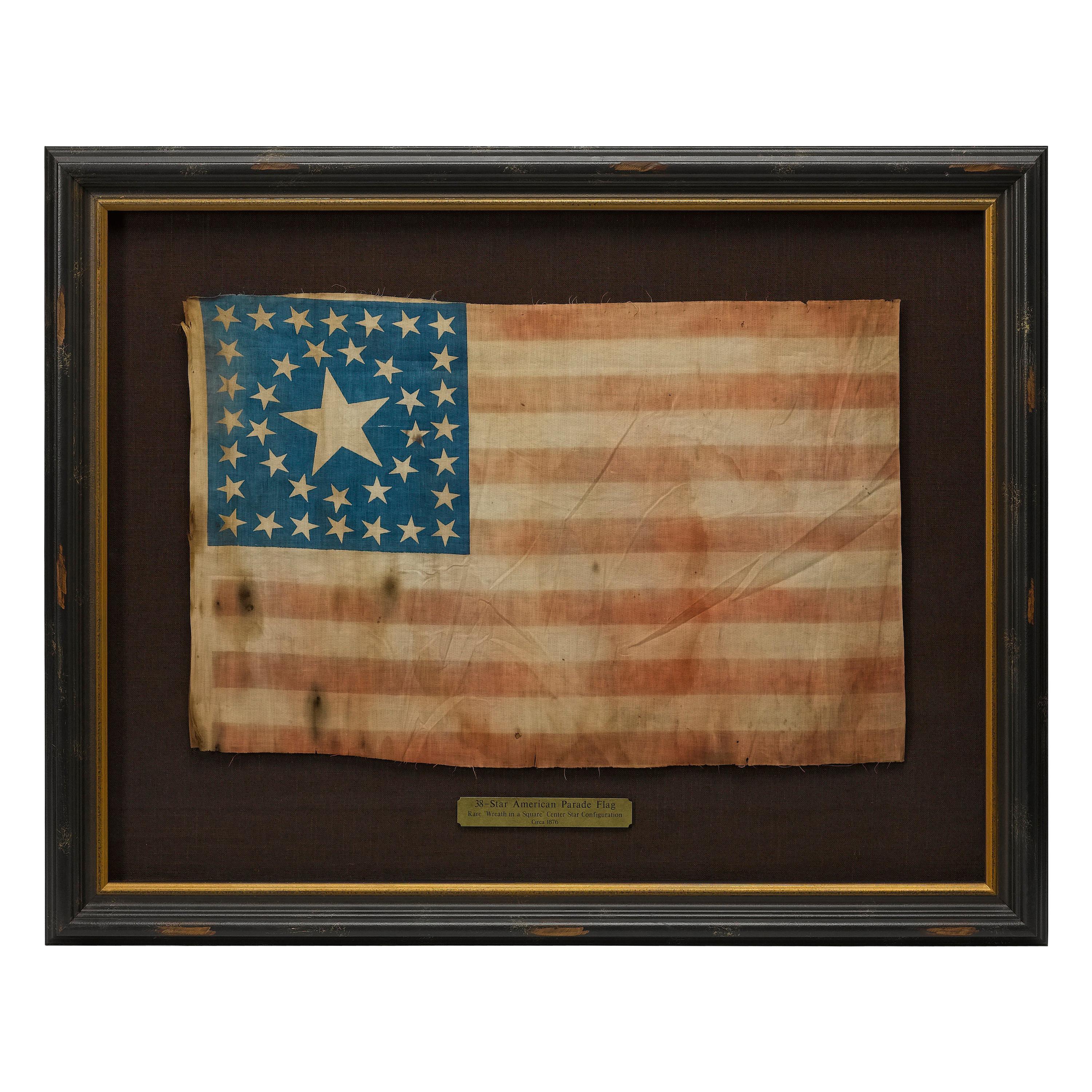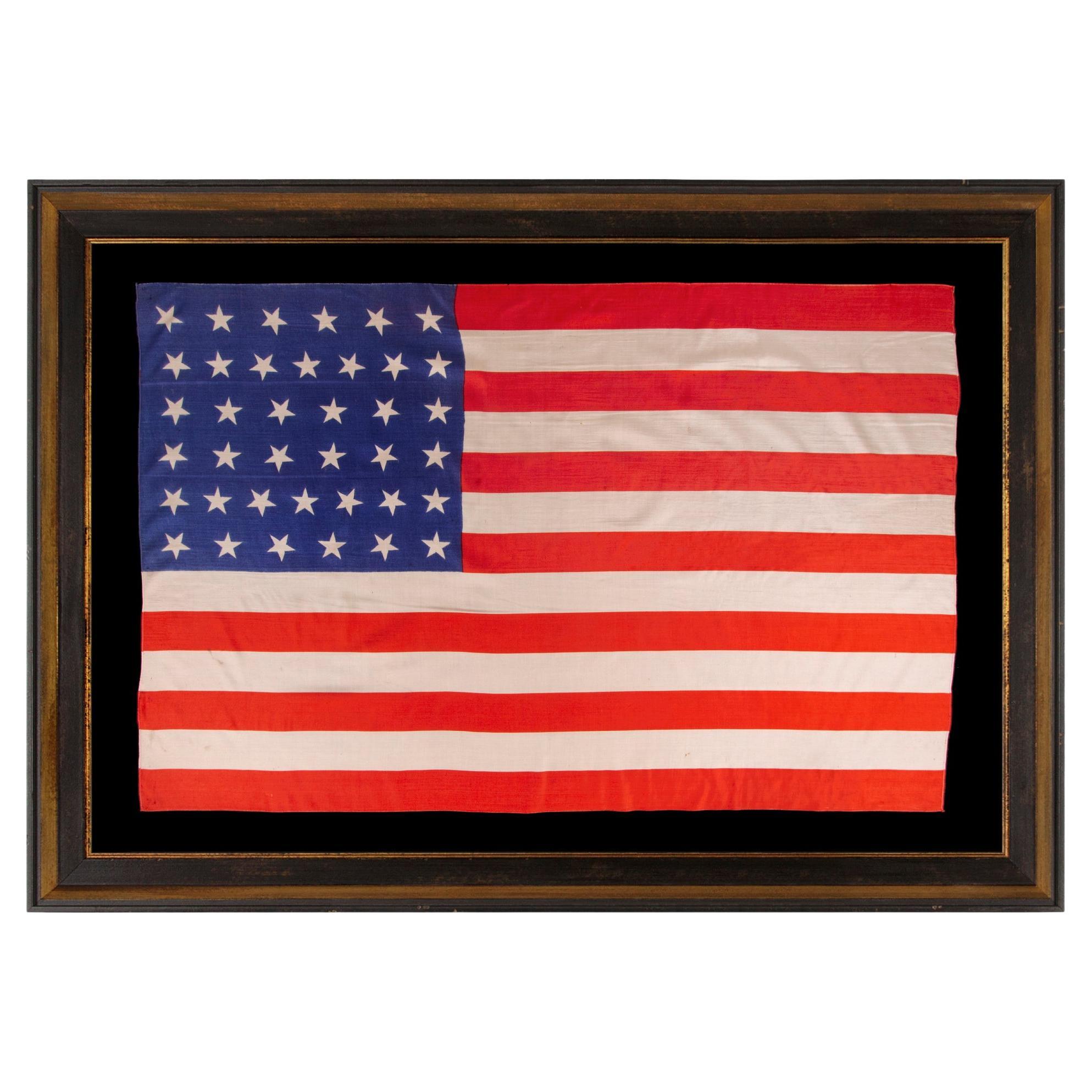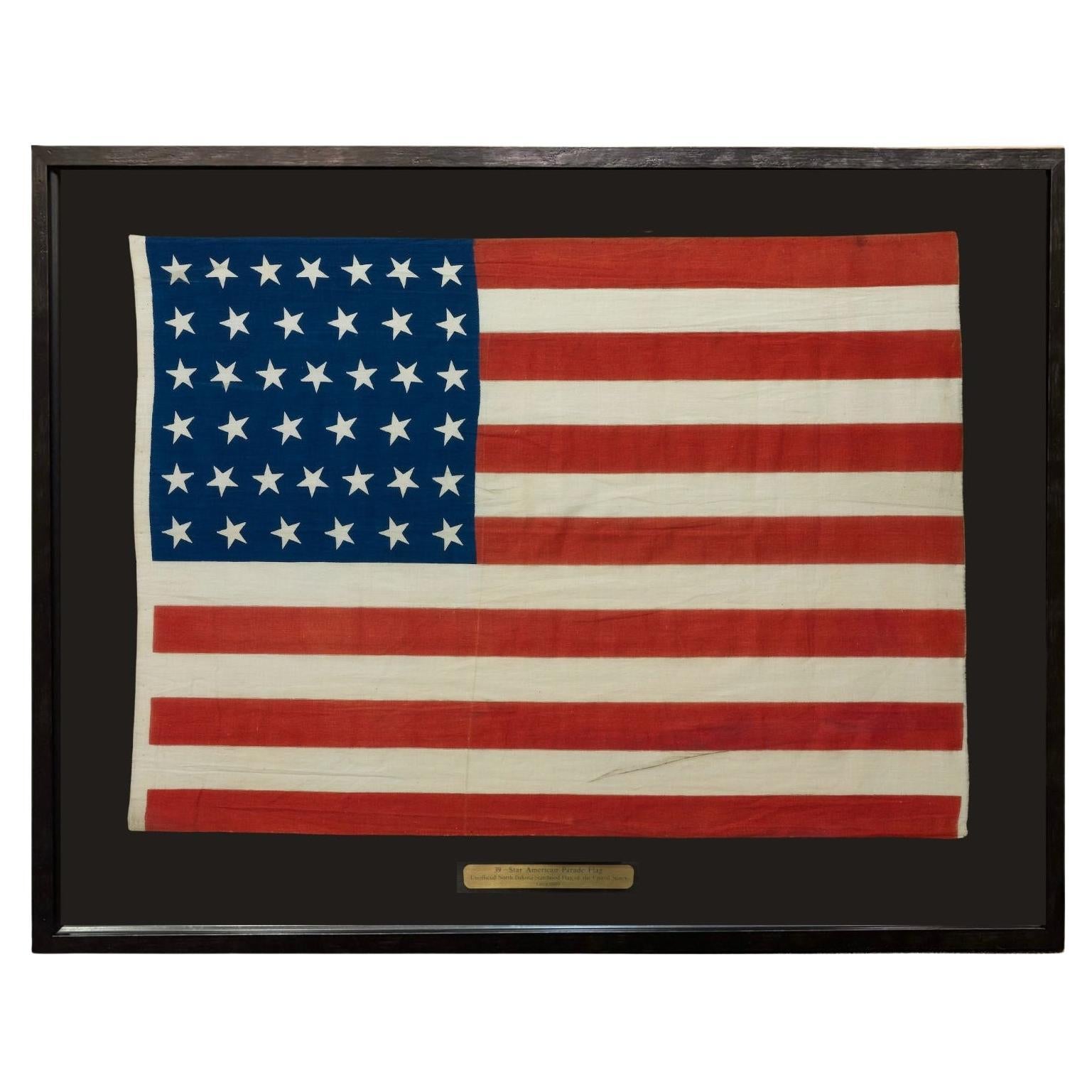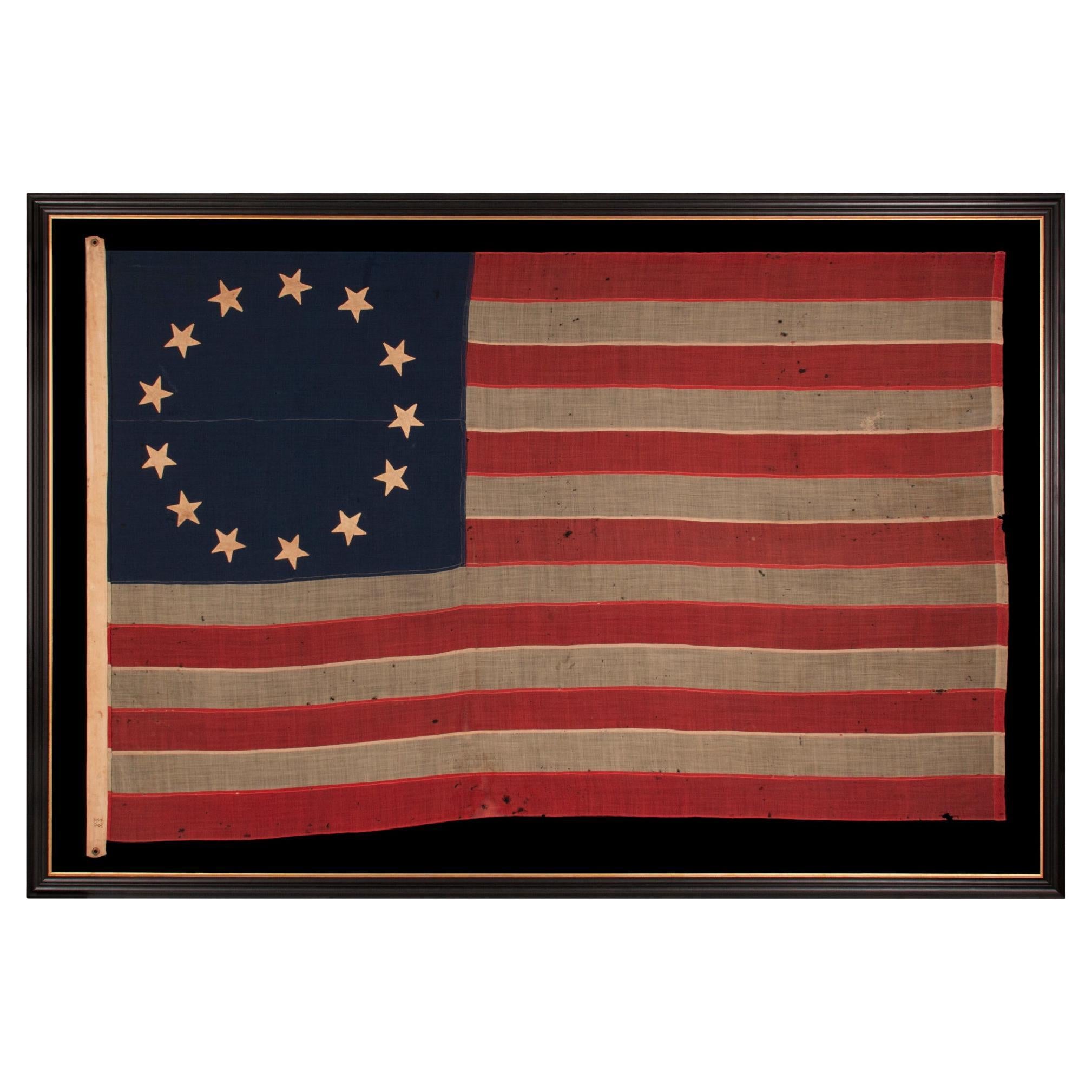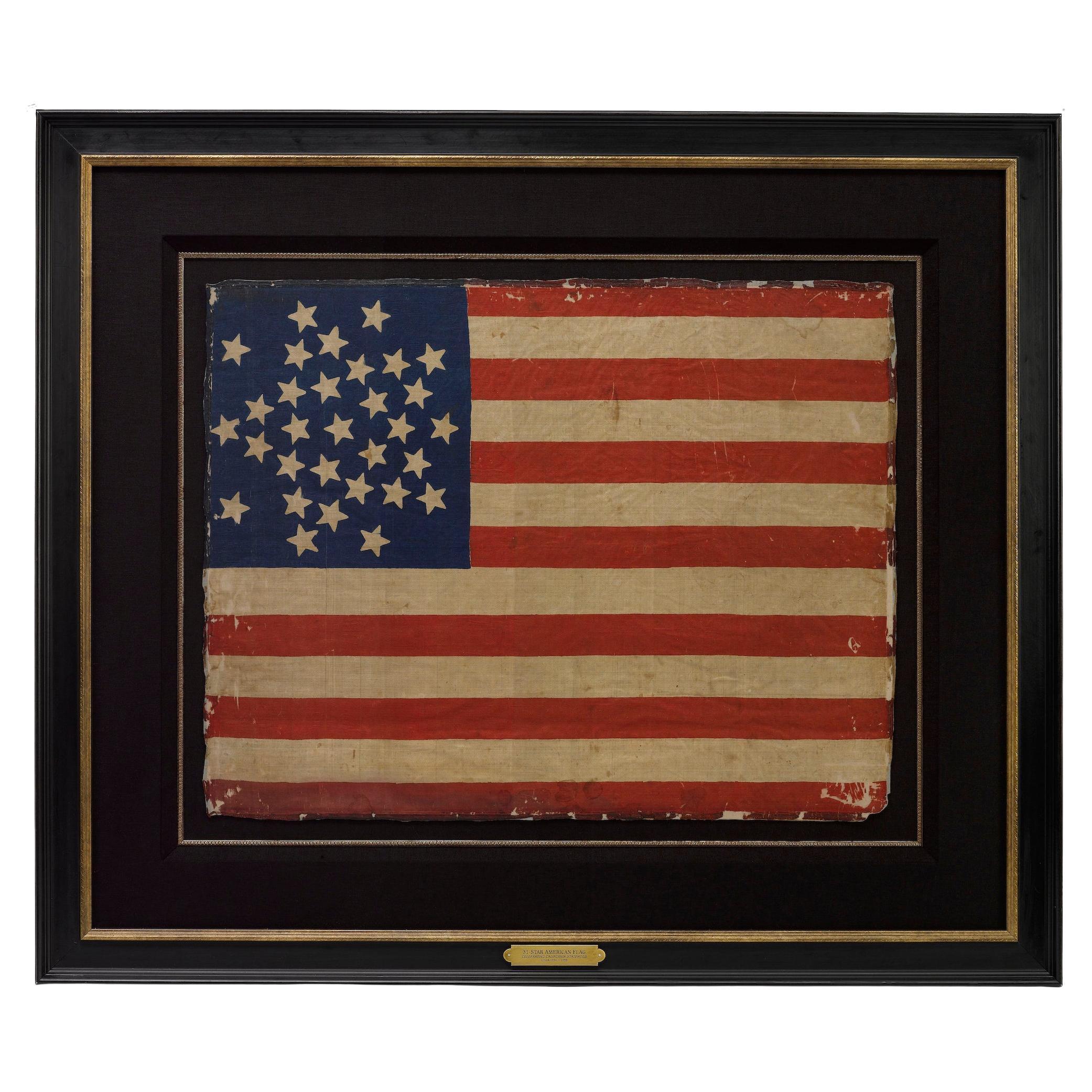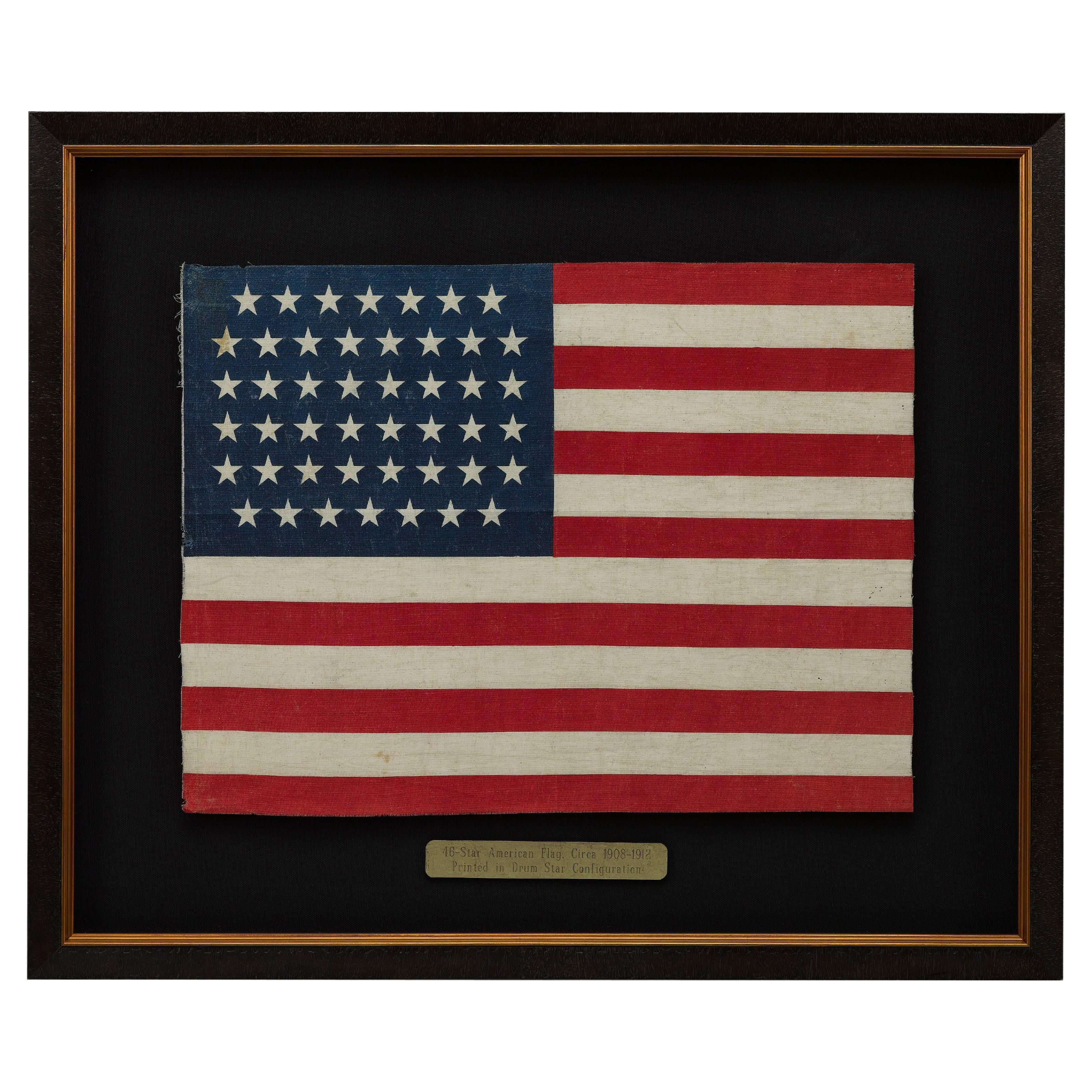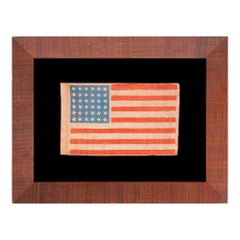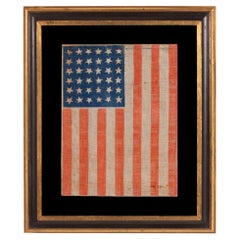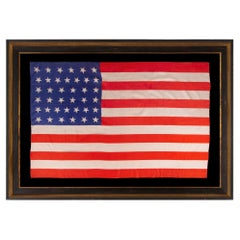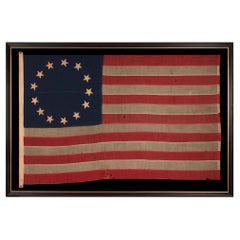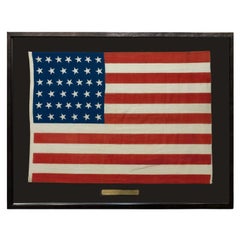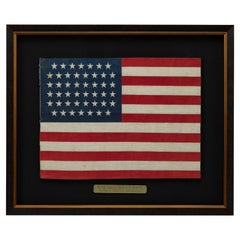Items Similar to 36 Star Antique American Flag, Cornflower blue Canton, circa 1864-1867, Nevada
Want more images or videos?
Request additional images or videos from the seller
1 of 6
36 Star Antique American Flag, Cornflower blue Canton, circa 1864-1867, Nevada
About the Item
Antique American Flag With 36 Stars On A Cornflower Blue Canton, Civil War Era, 1864-1867, Reflects The Addition Of Nevada As The 36th State; A Great Folk Exaple With Haphazard Rows Of Starfish-like Stars:
36 star American national flag of the Civil War era with outstanding collector traits. Haphazard rows of fat, starfish-shaped stars fill most of the confines of a brilliant, cornflower blue canton. Note the crude piecing of the thirteen, red and white stripes, joined in an ill-planned manner that results in great variation in width, as well as general irregularity. The 4th red stripe actually falls slightly below the canton, and the height of each does not line up with the corresponding stripe on the reverse. This can clearly be seen at the fly end, which is is turned back and bound to repair obvious extended use in an outdoor environment. Clearly the maker lacked experience in seam work. Lining up the necessary components, so that they could be viewed on both sides, presented a challenge they may have not previously faced. This is also evident in the sewing of the stars, which do not line up on the obverse and reverse sides, as they typically would in a flag sewn by an experienced flag-maker. That said, this is just this kind of homemade charm that fuels interest in early American flags among both flag collectors and collectors of American folk art. Even the wavy profile line of the fly end adds whimsical appeal.
The stars are hand-sewn, made of cotton, and are double-appliquéd (applied to both sides). The stripes and canton are made of cotton. The latter was joined to the striped field with hand-stitching along the fly end side and with treadle stitching along the lower edge. The stripes were pieced and joined with treadle stitching and there is a cotton binding along the hoist, bound in the same manner, with two hand-sewn, whip-stitched grommets. The color of the canton is especially attractive. Because there were no specified shades of red or blue until 1912, anything was possible.
Note how the proportions of the flag are rather close to square, and how the canton is actually taller than it is long. This format is similar to that of regulation, Civil War period, Union infantry battle flags, which were 6 x 6.5 feet. Even the proportions of the canton, being taller than it is long, is shared by many Civil War battle flags. Even though this is certainly not the flag’s original length—it having been properly hemmed so that it could see further use during this patriotic and heroic period—the resulting measurements are both interesting for a flag of this era, and very small among its counterparts. Because most 19th century flags with pieced-and-sewn construction were 8 feet in length or larger, making them difficult to frame and display in an indoor setting, both collectors and one-time buyers alike many times prefer smaller examples, like this one, which is bold enough to make a significant statement, yet manageable in scale.
Lincoln pushed Nevada through to statehood on October 31st, 1864, during the Civil War, and just 8 days before the November election. The territory’s wealth in silver was attractive to a nation struggling with the debts of war and so increased support for the Republican ticket. While the 36th star wasn't officially added until July 4th of the following year, some flag-makers would have begun adding the 36th star as early as July of 1864, several months before the addition of the state actually occurred, and almost all would have added it after Nevada was in. This would be especially true among homemade flags like this one. Adding stars before they were official was common practice during the late 19th century and reflects both the nation's desire for Westward Expansion and the hope of flag-makers to bring new star counts to market before their competitors. The 36 star flag was officially replaced by the 37 star flag in 1867, following the addition of Nebraska.
Mounting: The flag was mounted and framed within our own conservation department, which is led by expert staff. We take great care in the mounting and preservation of flags and have framed thousands of examples.
The background is 100% cotton twill, black in color, that has been washed and treated for color-fastness. The black-painted and hand-gilded molding is Italian. The glazing is U.V. protective plexiglass. Feel free to contact us for more details.
Condition: There is minor to modest foxing and staining throughout the white cotton fabric, accompanied by modest spots near the end of the 4th, 5th, and 10th stripes. There is a very small, dark spot near the canton in the 6th stripe. There are 4 tiny holes in the canton, accompanied by two lineal tears, with modest loss, near the center of the 5th stripe, and a tiny hole near the fly end in the last stripe. As previously noted, the fly end was turned back during the flag’s course of use. Many of my clients prefer early flags to show their age and history of use.
Frame Size (H x L): Approx. 50.5" x 65"
Flag Size (H x L): 39" x 53.5".
- Dimensions:Height: 50.5 in (128.27 cm)Width: 65 in (165.1 cm)Depth: 2.5 in (6.35 cm)
- Materials and Techniques:
- Place of Origin:
- Period:
- Date of Manufacture:1864-1867
- Condition:See Item Description.
- Seller Location:York County, PA
- Reference Number:Seller: 36j-8331stDibs: LU849725547132
About the Seller
5.0
Recognized Seller
These prestigious sellers are industry leaders and represent the highest echelon for item quality and design.
Established in 1991
1stDibs seller since 2008
69 sales on 1stDibs
Typical response time: 8 hours
- ShippingRetrieving quote...Shipping from: York County, PA
- Return Policy
Authenticity Guarantee
In the unlikely event there’s an issue with an item’s authenticity, contact us within 1 year for a full refund. DetailsMoney-Back Guarantee
If your item is not as described, is damaged in transit, or does not arrive, contact us within 7 days for a full refund. Details24-Hour Cancellation
You have a 24-hour grace period in which to reconsider your purchase, with no questions asked.Vetted Professional Sellers
Our world-class sellers must adhere to strict standards for service and quality, maintaining the integrity of our listings.Price-Match Guarantee
If you find that a seller listed the same item for a lower price elsewhere, we’ll match it.Trusted Global Delivery
Our best-in-class carrier network provides specialized shipping options worldwide, including custom delivery.More From This Seller
View All36 Star Antique American Parade Flag, with Canted Stars, ca 1864-1867
Located in York County, PA
36 STAR ANTIQUE AMERICAN PARADE FLAG WITH CANTED STARS IN DANCING ROWS, ON A BEAUTIFUL, CORNFLOWER BLUE CANTON; CIVIL WAR ERA, NEVADA STATEHOOD, 1864-1867
36 star antique American f...
Category
Antique 1860s American Political and Patriotic Memorabilia
Materials
Cotton
Price Upon Request
36 Star Antique Parade Flag, Vertical Position, Nevada Statehood, ca 1861-1867
Located in York County, PA
36 STAR ANTIQUE AMERICAN PARADE FLAG, WITH STARS THAT ALTERNATE IN THEIR VERTICAL POSITION FROM COLUMN TO COLUMN AND ROW-TO-ROW, PRINTED ON AN ESPECIALLY INTERESTING LENGTH OF COARSE...
Category
Antique Late 19th Century American Political and Patriotic Memorabilia
Materials
Cotton
38 Star Antique American Flag, Colorado Statehood, circa 1876-1889
Located in York County, PA
38 star antique American parade flag with scattered star orientation, made of silk, with generous scale and vivid colors, Colorado Statehood, 1876-1889
38 star American national p...
Category
Antique Late 19th Century American Political and Patriotic Memorabilia
Materials
Silk
Price Upon Request
13 Star Antique American Flag in the Betsy Ross Pattern, circa 1861-1865
Located in York County, PA
13 star antique American flag in the Betsy Ross pattern, one of just three examples that I have encountered that pre-date the 1890’s; an extraordinary find, civil war period (1861-1865) or just after, extremely large among its counterparts of all periods in this design:
Exceptional, early, American national flag, with 13 stars arranged in the circular wreath pattern most often attributed to Betsy Ross. Since there was no official configuration for the stars of the American flag until 1912, when our nation received its 47th and 48th states, the design, before that time, was left to the whims of the maker. This led to an almost unimaginable spectrum of star arrangements on the American flag during the 18th and 19th centuries. Even within the 13 star count, alone, there are at least 80 known patterns—more than the average person would even think possible.
13 star flags have been made throughout American history, from at least June 14th, 1777, when the first Flag Act was passed by Congress, until the present. They have been continuously produced for reasons both patriotic and utilitarian. Because this was the original number of stars on the American flag, representing the 13 colonies, it was appropriate for any device made in conjunction with celebrations or notions of American independence. 13 star flags were thus displayed at patriotic events, including, but certainly not limited to, such occasions as Lafayette’s final visit, in 1825-26, the nation’s centennial in 1876, and longstanding celebrations of Independence Day. From at least 1840 onward, 13 star flags were produced for presidential campaigns, drawing a parallel between the past and present struggles for freedom, and were carried by soldiers, during the Mexican and Civil Wars, for the same purpose. Throughout history, and even today, they are boldly displayed at every presidential inauguration.
13 star flags were flown by American ships both private and federal. The U.S. Navy used 13 stars on the ensigns made for small boats, because they wished the stars to be more easily discernable at a distance. Private ships often copied Navy practice, and when commercial flag makers first began to produce flags with pieced-and-sewn construction, in small sizes, in large quantity, they frequently employed the 13 star count.
Flags in the Betsy Ross design are widely admired, due to the longstanding popularity of the Ross family myth. While many Americans learned in grammar school that Betsy Ross made and designed our first flag, and that the stars appeared in a circular fashion, there is, unfortunately, no way to prove the claim. No colonial examples have survived with this pattern of stars. In fact, while arranging the stars in a single circle seems quite logical, among the various choices that might come to mind, early American flags with this star pattern are curiously absent. One of the interesting misconceptions about 13 star flags is that the Betsy Ross pattern, even if not the original design, must have been common in early America. Logic would suggest this, given the frequency with which it appears in modern times, but this isn’t actually the case. In fact, the pattern is seldom encountered anywhere until much later. In more than 30 years of buying and selling early Americana, and over 20 years of extensive focus on the American flag specifically, through aggressively buying, researching, evaluating, restoring, and curating exhibitions, I have thus far encountered just three examples of Betsy Ross pattern flags that I can confidently date prior to the 1890's.
No one knows what the first flag looked like. While there is no precise reason that the Betsy Ross design could not have been the first, one of the best arguments against it, is illustrated by the simple fact that so many 13 star flags exist without it. If the Ross configuration was the original, it stands to reason that the pattern would have been reproduced with at least some degree of frequency.
Research conducted by the National Museum of American History notes that the story of Betsy Ross making the very first American flag for General George Washington, in the company of George Ross and Robert Morris, entered into American consciousness about the time of the 1876 centennial. The tale was immensely popular among an American public eager for stories about the Revolution and its heroes. The first documentation of it appeared shortly beforehand, in 1870, in a paper written by Betsy’s grandson, William Canby, for the Pennsylvania Historical Society. At the time, Canby made no mention of how the flag was designed, save for the fact that it had 5-pointed stars, per his grandmother’s suggestion. Because no earlier documentation supports the story, most flag scholars feel it was a grand hoax, fabricated by Canby for his own interests. Nothing survives in the collective writings of the three men, for example, nor in records of their words and deeds, which are fairly extensive. As with most things, reality is perhaps somewhere in the middle ground, with some of the details based on fact and some on fiction, made up, misinterpreted, or imagined from family accounts.
The first time that a star configuration gets attached to the Ross story appears to have occurred during the last decade of the 19th century. In 1892, Charles Weisgerber painted a nine-by-twelve-foot rendition of the fabled meeting between Betsy and George Washington, in which there is a flag with a circular wreath. Shortly afterwards, in 1898, Betsy’s granddaughter and great-granddaughter began to make flags in the East Wing of Independence Hall in Philadelphia, selling them to tourists while disseminating the family folk tale. In that same year, Weisgerber and a “group of concerned citizens” sought to preserve Betsy’s former Philadelphia residence at 239 Arch Street, where she lived at the time the flag would have been sewed. Weisgerber moved his family into the house and immediately opened to the public the room in which Betsy was said to have worked her magic. Ten-cent memberships were sold to fund renovations and donors received a small calendar, to which a cotton 13 star Betsy Ross pattern parade flag was affixed. The effects of these events caused the Ross legend to stick and the story, with the corresponding flag design, has appeared ever since in more places than one could ever hope to count.
The stars of this particular flag are made of cotton, hand-sewn, and double-appliquéd (applied to both sides). The canton and stripes of the flag are made of wool bunting that has been pieced and joined with treadle stitching. There is a sailcloth canvas binding along the hoist, with two brass grommets, one each at the extreme top and bottom. Along this, on the obverse, near the bottom, are two, unusual characters, embroidered with brown thread. These may be letter “I’s,” possibly forming a the Roman Numeral “II.” They are followed by an inscription, in blue ink, that appears to read “A. N. Smith.” The first character is stylized, and may alternatively be a “D,” “H,” or perhaps a “J.” Note how the binding is extended beyond the top and bottom-most points. Though quite unusual, this is sometimes encountered in early examples. The folding of the wool bunting back onto itself, with the binding stitched so that part of the fold is exposed, tends to be an early characteristic. Common in Civil war flags...
Category
Antique 1860s American Political and Patriotic Memorabilia
Materials
Cotton
Price Upon Request
Hand-Sewn 13 Star Cornflower Blue 32 Foot Commission Pennant circa 1845-1865
Located in York County, PA
ENTIRELY HAND-SEWN, 32-FOOT, SHIP’S COMMISSION PENNANT OF THE 1845-1865 ERA, A HOMEMADE, COTTON EXAMPLE, WITH 13 STARS ON A CORNFLOWER BLUE CANTON, IN A BEAUTIFUL STATE OF PRESERVATION
Commission pennants are the distinguishing mark of a commissioned U.S. Navy ship. A ship becomes commissioned when the pennant is hoisted. Flown during both times of peace and war, the only time it is not flown is if a flag officer or civilian official is aboard and replaces it with their own flag. Flown at the topmast, this would be the first thing one would see coming over the horizon and identified the vessel as a warship.
Sometimes the owners of private ships mimicked the use of Navy signals. Some seafaring men would have served in the Navy and become privy to various practices in that capacity. Others flew them purely for stylistic reasons, either on a regular basis or while the boat was dressed for special occasion. Hudson River steamers regularly flew pennants of this nature, as evidenced by period photography as well as the paintings of artists such as John and James Bard...
Category
Antique Mid-19th Century American Political and Patriotic Memorabilia
Materials
Cotton
13 Star American Parade Flag with Rare Design, circa 1888 Ex Richard Pierce
Located in York County, PA
13 Star American parade flag in an extremely rare design, with “protection to home industries” slogan on a fanciful, scrolling streamer, made for the 1888 presidential campaign of Benjamin Harrison; formerly in the collection of Richard pierce.
1888 Benjamin Harrison campaign flag, printed on cotton, with 13 large stars in a 3-2-3-2-3 pattern, upon which a whimsical, scrolling streamer is superimposed that features the slogan: “Protection to Home Industries.”
There are numerous styles of both documented and undocumented, red, white, and blue bandanas and handkerchiefs, made for Harrison’s campaign in this year, as well as from the subsequent one, in 1892. Most bear variations of text to support the “Protection for American Industries” platform of the Republican Party. America was in the midst of the industrial age and there was a great deal of public interest, both in protecting growth and discouraging both imported goods and immigration. The constant stream of immigrants posed great challenges for a working families, competing for scarce jobs, in work environments that were already often far from ideal. In post-Civil War America, many of the working men were Civil War veterans.
Bandanas abound from Harrison’s Campaigns, but flags do not. This example, along with three others, were once part of an 1888 patriotic quilt that was disassembled by a dealer and sold piecemeal to collectors. I eventually acquired all four. Fifteen to twenty years ago, these were the only four known copies. A couple of others have since surfaced, but the total count known still stands closer to 5 than 10.
The use of 13 stars is seen in the flags of various candidates in the 19th century. Among these are Abraham Lincoln (1860 campaign), Henry Clay (1844 campaign), John Fremont (1856), and Benjamin Harrison’s grandfather, William Henry Harrison...
Category
Antique 1880s American Political and Patriotic Memorabilia
Materials
Cotton
You May Also Like
38-Star Antique American Flag with Unique Canton, circa 1876-1890
Located in Colorado Springs, CO
This is a striking 38-star American flag. The flag dates to 1876-1890, when Colorado (represented by the large star in the center of the flag’s canton) joined the Union as the 38th s...
Category
Antique Late 19th Century American Political and Patriotic Memorabilia
Materials
Muslin
39-Star Antique American Flag with 'Whimsical' Star Pattern, 1889
Located in Colorado Springs, CO
This is a 39-star unofficial American flag, handmade and printed on cotton. The flag dates to 1889 and has a unique history, thanks to its rare star-count.
The flag’s canton is prin...
Category
Antique 1880s American Political and Patriotic Memorabilia
Materials
Cotton
31-Star Printed American Flag, Celebrating California Statehood, Circa 1850
Located in Colorado Springs, CO
This is a rare 31-star medallion printed American flag, celebrating the addition of California to the Union. The flag is printed on silk and has a spectacular “Great Star” canton pat...
Category
Antique 1850s American Political and Patriotic Memorabilia
Materials
Silk
46-Star American Flag Printed in Drum Star Configuration
Located in Colorado Springs, CO
This is an original 46-Star American parade flag, celebrating Oklahoma statehood. Each star on the flag's canton represents a state in the Union at the time. The official flag design would update every July 4th, to include any new states added to the Union in the past year. Oklahoma, the 46th state, entered the Union on November 16, 1907. As such, this 46–star flag was the official flag of the United States from July 4, 1908, until July 4, 1912.
The silk flag has a dark blue canton with 46 white printed stars. The stars are printed in an 7-8-8-8-8-7 row configuration, or “Drum design.” The flag design is completed with 13 alternating red and white stripes, each stripe representing one of the original thirteen colonies.
The land that comprises Oklahoma today was added to the United States as part of the Louisiana Purchase of 1803. Throughout the 19th century, the U.S. government relocated Indian tribes from the southeastern United States to the area, and by 1900, over 30 Indian tribes had been moved to what was originally called the Indian Territories. At the same time, ranchers in Texas began to move into the area in search of new pasture lands. Although stipulations in the Indian Relocation Act agreed that the land would forever be Indian Territory, the promise of fertile farmland trumped the government’s promise of sovereignty.
On April 22, 1889, they opened the land to settlement by homesteaders, creating a land run in which settlers, called “Boomers,” were allowed to cross the Texas or Arkansas border at a particular hour to claim homesteads. Settlers who illegally crossed the border earlier to stake prime land were called “sooners,” which eventually became the state’s nickname. Wagons and the Santa Fe railroad carried cartloads of men and women to blank town sites and building plots, creating ten thousand-people communities in a matter of days. The following year, the region was further divided into Indian Territory and Oklahoma Territory...
Category
Vintage 1910s American Political and Patriotic Memorabilia
Materials
Silk
Antique Federal Eagle American 50 Star Flag with Brass Eagle Pole, 19th Century
Located in Oklahoma City, OK
Monumental 50 star American Flag with antique Federal Eagle brass and wood pole. A patriotic piece suitable for any home. This set includes both ...
Category
Antique 19th Century American Federal Political and Patriotic Memorabilia
Materials
Brass, Bronze
$4,800 Sale Price
20% Off
Antique 13-Star Patriotic Sash by Louis E. Stilz & Bros., Late 19th Century
Located in Colorado Springs, CO
Presented is an original patriotic sash from the late 19th century, featuring 13 stars against a bright blue field. This sash features appliqued silver stars on a blue canton, red an...
Category
Antique Late 19th Century American Historical Memorabilia
Materials
Cotton
Recently Viewed
View AllMore Ways To Browse
Blue Antique Fabrics
American Gilded Age Furniture
Antique American Flag Framed
Brown And White Striped Fabric
Small American Flag
American Flag Cotton
Folk Art Applique
Circa 10th
Battle Flag
Black And White Painted 19th Century Italian
Fox Stars
Antique Hoist
Stars Black Hole
Fly Line Italy
Blue Star Flag
Civil War Memorabillia
Silver Binding
Civil War Flags
